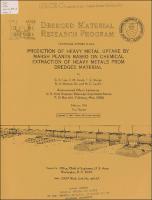Please use this identifier to cite or link to this item:
https://hdl.handle.net/11681/47215| Title: | Prediction of heavy metal uptake by marsh plants based on chemical extraction of heavy metals from dredged material |
| Authors: | Lee, Charles R. Smart, R. Michael Sturgis, Thomas C. Gordon, Robert N. Landin, Mary Collins, 1941- |
| Keywords: | Marsh plants--Effect of heavy metals on Plants--Effect of heavy metals on Dredging spoil--Environmental aspects Dredged material--Environmental aspects |
| Publisher: | U.S. Army Engineer Waterways Experiment Station |
| Series/Report no.: | Technical Report (Dredged Material Research Program (U.S.));no. D-78-6 |
| Abstract: | A field and laboratory study was conducted to establish the extent of heavy metal absorption and uptake by marsh plant species from dredged material and to develop a technique using chemical extraction of heavy metals from dredged material to predict the concentration of heavy metals in marsh plants subsequently grown on the dredged material. Extensive field sampling of marsh plants and dredged material from U. S. Army Corps of Engineers (CE) disposal sites was conducted along the East and Gulf Coasts of the United States. Marsh plant species studied included Spartina alterniflora, Spartina patens, and Distichlis spicata. Four procedures for the extraction of heavy metals from soil were evaluated including water soluble, ammonium acetate exchangeable, dilute acid extractable, and DTPA extractable. Results indicated that most marsh plants colonizing dredged material disposal sites sampled in this study contained relatively low concentrations of Zn, Cu, Cd, Pb, Cr, Ni, and Hg. These concentrations were very similar to those reported for natural coastal marshes. There were a few locations, however, in which the concentrations of Zn, Cu, Cd, and Pb in the marsh plants were an order of magnitude greater than the concentrations measured in the majority of marsh plants. The occurrence of these elevated concentrations of heavy metals emphasizes the need for a method to predict heavy metal availability from dredged material to plants. DTPA extraction of heavy metals gave the best correlations with actual heavy metal concentrations in marsh plants. The other procedures were limited to one or two heavy metals and only one of the three marsh plant species studied. Marsh plant uptake of Zn, Cu, Cd, and, to some extent, Pb and Cr from dredged material can be predicted using a DTPA extraction procedure. Prediction of plant uptake of Ni or Hg was not possible in this study. Additional verification tests are required to reconfirm and better substantiate the accuracy of the prediction equations developed in this study. Additional research is recommended to improve and expand the prediction equations developed in this study to include dredged material containing higher concentrations of heavy metals and placed under different disposal conditions, such as flooded and upland. Prediction of heavy metal availability in dredged material under various disposal conditions will enhance the ability of CE District personnel to dispose of dredged material in an environmentally compatible manner. |
| Description: | Technical Report |
| Gov't Doc #: | Technical Report D-78-6 |
| Rights: | Approved for Public Release; Distribution is Unlimited |
| URI: | https://hdl.handle.net/11681/47215 |
| Appears in Collections: | Technical Report |
Files in This Item:
| File | Description | Size | Format | |
|---|---|---|---|---|
| Technical Report D-78-6.pdf | 5.97 MB | Adobe PDF |  View/Open |